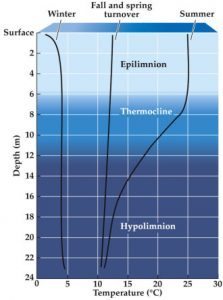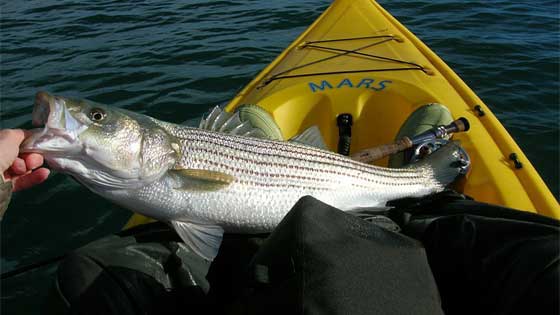Striped Bass Lake Fishing

Striped Bass swim throughout a lake and are hard to track at most times during the season, except in late spring.
Around the same time that Striped Bass are returning to the lake from smaller streams, schools of gizzard and threadfin shad begin to spawn nightly in the shallow bays. Striped Bass ambush the spawning shad from deep water, intercepting the schools as they move into shallow water to spawn.
When you’re fishing for Striped Bass during the summer months, using a fish finder is very helpful in finding Stripers while they’re still hiding in the deep.
Lake night fishing – how to fish for stripers
- Use heavy spinning equipment with a 20lb test line
- Cast a deep-running crank bait parallel to the shore in a rocky area that features a 10 or 20 foot drop-off
- It’s important to keep your boat motor to a minimum so you don’t scare away the striped bass. Especially at night when their senses are effectively down
- Pace the lure at a medium speed to ensure that the lure maintains it’s maximum depth
- Using a sonar will increase your success fishing at night
- Loud rattle crankbaits filled with split shot attract both stripers and impressively sizes largemouth’s
If you’re wanting to buy a sonar detector, we’ve sourced the best prices here
 Much is made of Striped Bass moving to cool water in the summer and avoiding direct sunlight. However when stripers head deeper, they’re also seeking out well oxygenated water.
Much is made of Striped Bass moving to cool water in the summer and avoiding direct sunlight. However when stripers head deeper, they’re also seeking out well oxygenated water.
What is a thermocline?
Use temperature sensors to find the cool, oxygen-rich thermoclines.
The layer above the thermocline is called the epilimnion. It’s characterized by warm water, low in oxygen content.
The hypolimnion is the layer below the thermocline and is cold being low in oxygen content.
This oxygen-rich thermocline layer changes its position constantly, much the same way that the jet stream moves.
However, what’s important is that this thermocline attracts many varieties of fish, which attract the striper bass.
Lake trolling
While a depth finder may determine where a striper is swimming, the striped bass doesn’t remain in one area for long.
Fish the areas likely to hold fish, in the thermocline layer, at drop-offs, in the lower half of the lake, along river channels, over submerged islands, and ridges in the thermocline layer.
Bait
Use live shad and minnow bait or large jigs along dams at depths of 20 or 40 feet.



